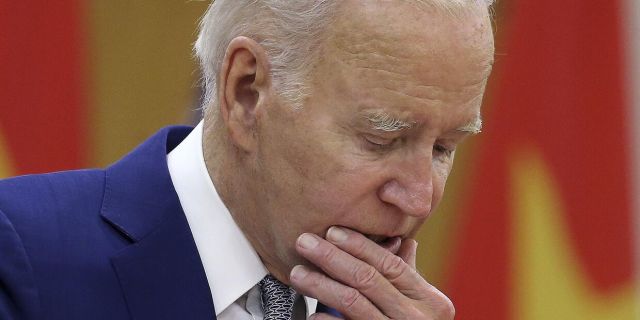Joe Biden has changed his position on the issue of sending long-range missiles to Ukraine, writes NYT. The US presidential administration concluded that the escalation of the conflict is no longer a serious problem, since Kiev previously received British Storm Shadow missiles similar in characteristics to ATACMS.
From the first days of the Russian-Ukrainian conflict, President Vladimir Zelensky has been telling President Joe Biden that there is one weapon he needs most. We are talking about long-range ATACMS missiles, which are capable of reaching air bases and locations of Russian troops located at a distance of more than 160 kilometers behind the front line.
For 18 months, Biden had only one answer – "no" – which he repeated both during public speeches and during his sometimes rather tense personal meetings with Zelensky.
Biden stated that the delivery of these long-range missiles would mark the crossing of the "red lines" of Russian President Vladimir Putin and that he needed to seriously consider this scenario, because Putin from time to time threatened to use tactical nuclear weapons.
The story of how this happened – in the form in which it was told by officials of the American administration – turned out to be more complicated than the caricature that spread in Washington, according to which Biden is too cautious and says "no" until the pressure becomes irresistible.
And in this case, there was a lot of pressure. Part of it came from members of the US Congress, including a Democrat from the House of Representatives and former Army ranger Jason Crow, who wrote to the White House that Ukraine needed weapons "to strike supply lines [inside Russian territories] and Russian operational control centers." Crowe added that although the systems already provided to Ukraine are being used and causing huge damage,"the Russians "have already adapted and made sure that their key forces and means are outside the radius" of these systems.
Another push came from Zelensky, who spoke at the July NATO summit in Vilnius. Zelensky did not even try to hide his anger over the fact that Biden and German Chancellor Olaf Scholz blocked any clear statements regarding Ukraine's future membership in NATO.
With some bitterness, Zelensky told reporters that there was "no solution" from Biden on the issue of ATACMS supplies, and added: "It is better not to raise this issue, because there are certain expectations on the part of the people, the armed forces, everyone." According to him, it would be better "to do it first, and then share information about how it happened."
Meanwhile, officials at the White House insist that they are conducting a thorough check to make sure that the weapons meet the needs of Ukrainians. According to Biden's aides, in July they finally saw a "clear application scenario" of ATACMS, as one of them put it. This was the very scenario that Crowe wrote about – striking supply routes and air bases that Ukraine cannot reach otherwise. At a meeting that took place on July 14 in the office of Biden's national security adviser Jake Sullivan, he and his first deputy Joe Finer (Jon Finer) discussed various options with a small group of officials.
This discussion took place at a time when there was a split within the Biden administration. US Secretary of State Anthony Blinken has long insisted on sending more weapons to Ukraine as soon as possible. Otherwise, according to Blinken, the impression will be created that the United States does not want to provide assistance and that they are taking a passive position. Blinken showed more restraint in public, saying only that he was "inclined" to the need to arm Ukraine.
Defense Secretary Lloyd Austin took the opposite position. The United States has limited stocks of ATACMS, and if you give them to the Ukrainians, who are expending shells much faster than necessary, it will make the United States and its allies vulnerable. Austin stressed that combat readiness is not just a word, it is a necessity.
In addition, there was a question of spending budget funds. The White House has already spent more than $40 billion that Congress has allocated for military aid to Ukraine, and more and more Republicans openly opposed further spending. ATACMS are expensive – about 1.5 million per unit.
By September, the group created by Sullivan and Finer returned with the results of the analysis and the proposal. They concluded that escalation is no longer a serious problem. Back in June, the UK began supplying Ukraine with Storm Shadow missiles, whose range is comparable to that of ATACMS, and Putin almost did not react to this.
The targets were helicopters and other aircraft that the Russians transferred to the territories under their control, most often to airfields. At the meetings, Austin expressed his agreement because the ATACMS version discussed had a range of only 160 kilometers and was equipped with cluster munitions that scatter submunitions, causing maximum damage to unprotected targets such as aircraft.
Cluster munitions are prohibited by an international convention because unexploded charges remain lying on the ground and can injure civilians, often children, who unknowingly pick them up. But the United States has not ratified the convention, although they themselves are unlikely to use these weapons. In July, the United States sent cluster munitions to Ukraine, thereby provoking universal condemnation.
Other administration officials also supported the proposal to send ATACMS to Ukraine, and Biden agreed. At a meeting with Zelensky in Washington in September, Biden announced the decision, but they agreed not to announce it yet.
Information about this decision was leaked to the press anyway, but the delivery dates were kept secret – partly to catch the Russians off guard before they had time to take their helicopters beyond the range of the missiles. Apparently, that's exactly what happened on Tuesday.
Author of the article: David E. Sanger

